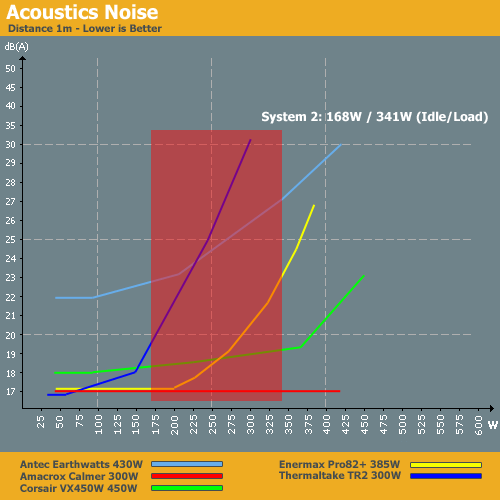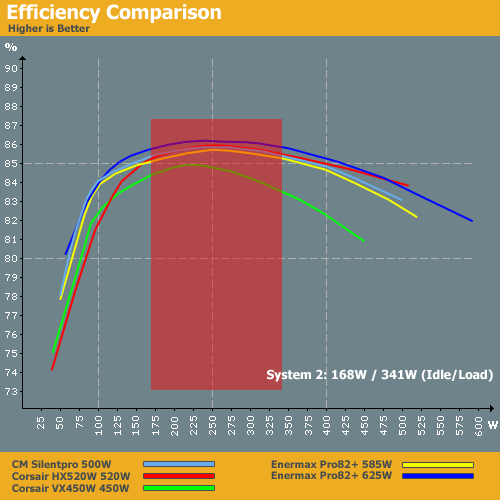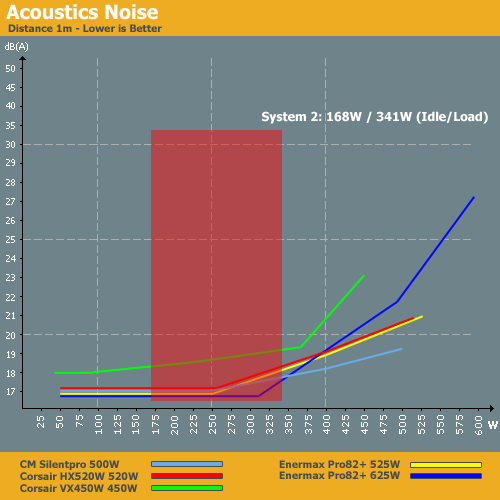Debunking Power Supply Myths
by Christoph Katzer on September 22, 2008 3:00 AM EST- Posted in
- Cases/Cooling/PSUs
PSUs for Midrange Systems
Our midrange system opens up a lot more in the way of potential power supplies, as there are far more manufacturers building 400W to 500W PSUs. Our idle power consumption in this case is 168W, which is quite high when compared to the 120W a high-end system would have used a few years back (i.e. AMD Athlon 64 4000+ and NVIDIA GeForce 7800 GTX under full load). However, times change and we see increased power requirements along with performance improvements.
Our selection of power supplies uses the same criteria as before. We will also see how our entry-level power supplies and all this sort of system.
- Cooler Master Silent Pro (500W) actively cooled
- Corsair HX520W (520W) actively cooled
- Corsair VX450W (450W) actively cooled
- Enermax Pro82+ (585W) actively cooled
- Enermax Pro82+ (625W) actively cooled


In terms of efficiency as well as the ability to supply sufficient power, all of the power supplies are able to run this midrange setup except for the 300W Thermaltake unit. The Antec Earthwatts has been around for a while, so it's not surprising that it doesn't perform as well as newer models, but it still delivers decent if not great efficiency. Noise levels are a different matter, and we would be inclined to avoid most of the entry-level PSUs. If noise isn't a consideration, all but the Antec will work; however, the Corsair VX450W performs best out of these units in so we will carry it along to the next level and include it with the midrange offerings.
Efficiency is Not the Issue

With the addition of some higher performing power supplies, efficiency clearly shouldn't be the overriding concern for a computer like our midrange system. The Corsair VX450W doesn't look as good in this graph, although 83% efficiency certainly isn't anything to cry about. The newer models all reach efficiency of around 85% to 86% throughout the midrange system load. Comparing the two scenarios, outside of PSUs that simply can't provide enough power it's not necessary to move up to a higher performance power supply. You want to look at other aspects such as features, warranty, and noise levels before making a decision.

In terms of noise levels, all of these units perform very well and can provide a quiet computing environment. We also see a clear separation between the entry-level PSUs in the midrange PSUs in this chart, since the midrange units are running a 75% load at worst. Again, if you've had the mindset that 600W and higher PSUs are required for modern midrange systems, the above charts should help dispel that myth. If you can find a good quality 400W PSU, it can easily power a midrange system. However, 500W PSUs generally make the best fit, as they provide optimal efficiency and lower noise.










98 Comments
View All Comments
BernardP - Monday, September 22, 2008 - link
The following paragraph from the article has me puzzled:"It's important to have one 12V rail supply the CPU with power and the second rail for the PCI-E slots and 6-pin connector. Unfortunately, many companies make a tremendous mistake when it comes to power distribution. We have seen several power supplies that use one 12V rail for the 6-pin PEG connector and then a second 12V rail for the CPU and 24-pin ATX connector. That means if you have a graphics card that doesn't include a 6-pin jack, both the CPU and GPU will use the same 12V rail for power. In this case, the second 12V rail goes completely unused, and users risk drawing too much current on the remaining 12V rail."
I have an Antec Eartwatts 380. How can I find out if Antec has made the tremendous mistake or not? I want to make sure that the 6-pin connector and PCI-E slot are on their own 12V rail. Antec litterature on this PS says:
"Dual 12V outputs: 12V2 for motherboard and peripherals, 12V1 for processor"
It would seem OK, assuming "peripherals" includes the 6-pin connector.
7Enigma - Monday, September 22, 2008 - link
What is your graphics card? From the article it seems to me they are saying if you do NOT have a card that requires a 6-pin PEG connector then you could possibly have an issue. If you have a card requiring a PEG connector you don't have to worry.BernardP - Monday, September 22, 2008 - link
Exactly. I am planning to add a 9500GT to my existing system (integrated graphics). No power connector on that card.Dribble - Monday, September 22, 2008 - link
http://extreme.outervision.com/powercalc.jsp">http://extreme.outervision.com/powercalc.jspSeems to return sensible values, and not only does it cover pretty well every component you might come across, but it also understands overclocking, over volting, and allows you to enter a value for capacitor ageing.
Also, here is a thread which someone has helpfully listed real power requirements (as given in reviews) for pretty well all graphic cards on the market right now:
http://archive.atomicmpc.com.au/forums.asp?s=2&...">http://archive.atomicmpc.com.au/forums.asp?s=2&...
drank12quartsstrohsbeer - Monday, September 22, 2008 - link
Hey Guys: Remember that decibels is a logrithmic scale of measurement! Using a linear scale on the graph leads to inappropriate conclusions being drawn from the data.7Enigma - Monday, September 22, 2008 - link
I don't think it does. Maybe a quick *note* at the beginning of the acoustics section mentioning its logrithmic, but it is very easy to read a linear scale.Also, the majority of the tested systems fall well below the floor of most systems (20 decibels), so it is a moot point anyway.
gmkmay - Monday, September 22, 2008 - link
I'll start off by saying good article, however I would have liked to see a few additions.Other than the aforementioned new cards and overclocking information I think it would have been helpful to include common watercooling pumps and case/system fans. There is most likely a large enough set reading this that would have liked to see those added.
The problem with the power supply issue is you have to be really careful not to get something too weak...and its really easy to forget a few small items that can quickly add up (for instance 2 pumps, 8 120mm fans, etc).
mindless1 - Thursday, September 25, 2008 - link
Nobody building a PC needs 8 x 120mm fans. Let's suppose you throttle down the fans enough that you might actually have good use for so many to have them all at very low RPM. That would tend to cause under 150mA per fan or barely over 1A total, a relatively trivial amount of power considering that even spinning up any one hard drive causes a larger momentary spike.A couple pumps shouldn't use all that much power either, but if you're pouring enough money into the system to have it that elaborate then why would you be on the fence about choosing a marginally capable PSU versus one with plenty of reserve power to the point where 3A one way or the other isn't a factor?
Anubis - Monday, September 22, 2008 - link
would be interesting to see numbers on just how much power OCing pulls over a non OCed systemChristoph Katzer - Monday, September 22, 2008 - link
I had a QX9770 just slightly overclocked with basic bios functions (for an oc-noob like me) and already then it had an increased power draw of 20% at full load compared to normal.